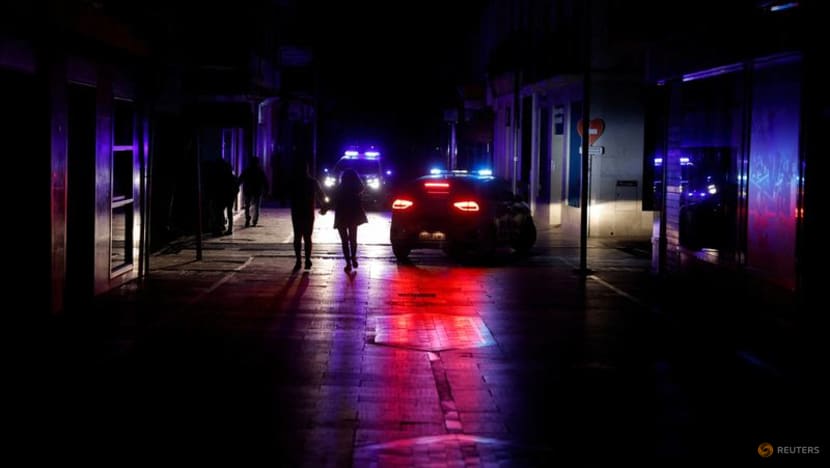Commentary: Spain power outage is a case study for countries switching to clean energy
While adopting clean and diverse forms of renewable energy is the right step, it can lead to a less robust power grid, says Alvin Chew of the S Rajaratnam School of International Studies.

People walk along a shopping street without electric lighting as police cars patrol to prevent theft and looting in the stores during the large-scale power outage in Ronda, Spain, Apr 28, 2025. (Photo: Reutesr/Jon Nazca)

This audio is generated by an AI tool.
SINGPORE: On Apr 28, swaths of Spain and Portugal suffered a power outage that ground life to a standstill. The blackout knocked out communication and transport systems, shut down industries and halted commercial services. Power was only restored ten hours later.
The Spanish government ruled out the possibility of a cyberattack on its national power grid. After preliminary investigations, it found that a sudden loss of power generation at a Granada substation triggered the blackout.
Efforts to determine the events leading to the blackout are ongoing, but experts have alluded to grid instabilities arising from the Iberian Peninsula’s reliance on renewable energy.
GRID INSTABILITY FROM RENEWABLES
Spain’s push towards green energy has led to an ambitious phase-out of fossil fuel as well as nuclear power plants. As of 2024, the nation generates almost 60 per cent of its electricity from renewable sources - wind, solar and hydropower.
By drawing power from different resources, particularly households running solar power, the grid becomes less robust. In the week leading up to the blackout, Spain’s electricity grid had experienced several imbalances.
A few minutes prior to the power outage, data showed the grid experienced a surge in wind power supplies. Hence, other resources such as nuclear, hydropower and solar were reduced to even out the supply to the grid, thereby optimising the cost of electricity produced in the market.
It was tracked that the smart grid system blocked out a significant supply of solar power due to the increase in wind power. Data showed that the sharp decline in solar power, from 18 gigawatts to 8 gigawatts in just a few seconds, could have caused the grid to become unstable and collapse.
Although the management of electricity from different resources happens daily, fluctuations in the grid are usually moderated with baseload power, which could come in the form of fossil fuels, nuclear or hydropower. Thermo- or hydro-turbines would have the “inertia” to produce electricity for a few minutes even if power from these resources have been cut off – an important characteristic of baseload power.
Solar power does not utilise turbines but rather relies on electric converters to transform direct current into alternating current, which is subsequently fed into the grid.
Moments before the blackout occurred, Spain was running on 60 per cent solar power. The sudden switch from solar to wind power could have tripped the threshold of the grid frequency.
DECARBONISATION IS KEY, BUT BASELOAD POWER REMAINS CRITICAL
Spanish Prime Minister Pedro Sanchez said excess renewables were not to be blamed for the blackout. He pointed out that street lamps and traffic lights running on solar panels were still operating during the power outage.
Households and businesses with solar panels and backup battery storages were also unaffected. Indeed, these households and businesses survived the power outage because their solar panels were off-grid.
While Spain can be commended in its effort to decarbonise its power sector through the diversification of clean energy resources, its reliance on intermittent solar and wind power requires rigorous management to make the grid network less prone to instabilities.
Baseload power is critical in making the grids more resilient. Unlike solar, nuclear is a stable source of energy that can be used as a baseload power supply.
Mr Sanchez said that there was no evidence to show that nuclear power could have prevented a blackout or quickened the restoration of power supply. Four nuclear plants went offline during the outage. He accused nuclear power advocates of using the outage to lobby for the energy source – which while clean, is not renewable and produces radioactive waste.
However, a country’s national grid will be vulnerable to power outages if it does not have the capacity for baseload power generation. The decision to turn off baseload nuclear power and feed in renewables is because Spain’s grid has been optimised so that electricity from renewables is cheaper than nuclear, particularly during seasons when there are excessive solar or wind power.
Spain can have a fully clean source of electricity production by including nuclear in its energy mix. The key consideration is baseload power generation, which is a feature of power stability rather than economic viability.
Norway, for instance, relies predominantly on renewable energy for electricity production. More than 95 per cent of its electricity generated comes from hydropower – a renewable source that can also serve as a form of baseload power.
Spain’s decision to phase out nuclear power by 2027 is as controversial as Germany’s decision to shut down its nuclear power plants. Germany’s phase-out of nuclear power has increased its dependence on coal and natural gas as a baseload power needed for critical infrastructure and industries, which ironically leads to an increase in carbon emissions.
Several European countries have since made a U-turn on their nuclear phase-out plans. In 2023, Sweden revived its plan to build new nuclear plants after decades of nuclear abandonment. Italy signalled it will reverse its ban on nuclear power in 2025, while Belgium recently repealed a law to scrap nuclear energy, citing it as imperative for energy independence and decarbonisation.
LESSONS FOR ASEAN
Presently, Southeast Asia does not have any operating nuclear plants to produce clean energy. The ASEAN power grid, long in the making, will allow countries to trade green electricity with each other. Presently, there are 13 established links out of 27 planned ones, generating about 5 gigawatts of electricity.
The electricity that feeds into the ASEAN power grid will primarily be produced from renewable sources in the region. The recent blackout in Spain shows how an overreliance on solar and wind power can lead to grid instabilities. Hence, the adoption of nuclear energy in the future can enhance regional energy security and add resilience to the common grid serving Southeast Asia.
Alvin Chew is Senior Fellow at the S Rajaratnam School of International Studies (RSIS), Nanyang Technological University (NTU).
















